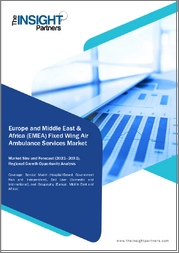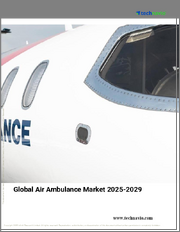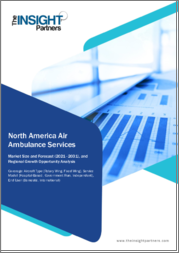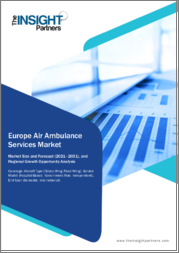
|
시장보고서
상품코드
1675827
세계의 에어 앰뷸런스 시장 규모, 점유율, 동향, 예측 : 비클 유형별, 서비스 유형별, 용도별, 지역별(2025-2033년)Air Ambulance Market Size, Share, Trends and Forecast by Vehicle Type, Service Type, Application, and Region, 2025-2033 |
||||||
에어 앰뷸런스 세계 시장 규모는 2024년에 64억 달러에 달했습니다. IMARC Group은 2033년에는 147억 달러에 달하고, 2025-2033년 CAGR은 9.71%를 나타낼 것으로 예측했습니다. 현재 북미가 시장을 독점하고 있으며, 2024년 시장 점유율은 48.2%를 초과할 것으로 예상됩니다. 응급 의료 서비스에 대한 수요 증가, 항공 의료 이송 기술의 대폭적인 발전, 의료비 지출 증가는 이 지역 시장의 급격한 성장 요인으로 작용하고 있습니다.
위기 상황에서 신속한 의료 대응에 대한 요구가 증가하면서 시장 성장 촉진
에어 앰뷸런스은 신속하게 현장에 도착하여 필요한 치료를 필요로 하는 환자를 적시에 신속하게 이송할 수 있습니다. 교통 체증이 심한 인구 밀집 도시 지역에서는 교통 체증을 우회하여 목적지에 신속하게 도착하고 신속한 의료 대응과 적절한 의료 시설로의 적시 이송을 보장할 수 있기 때문에 에어 앰뷸런스이 유리합니다. 이처럼 응급의료 대응에 대한 요구가 높아지는 것이 세계 시장 성장의 주요 요인 중 하나입니다.
에어 앰뷸런스란?
에어 앰뷸런스란 특수 의료장비를 갖추고 긴급한 의료처치가 필요한 환자나 장거리 또는 원격지의 의료시설로 이송이 필요한 환자에게 의료처치 및 이송을 제공하기 위한 인력을 배치한 것을 말합니다. 구급대원, 간호사, 의사가 참여하며, 공중 전용 차량으로 현지로 이송됩니다. 또한, 1차적 인명구조(BLS)와 이차적 인명구조(ALS)를 위한 장비도 내장되어 있습니다. 통신 및 운송 시스템, 병원, 외상센터, 전문의료센터, 재활시설과 연결하여 환자에게 최적의 케어를 제공합니다. 거리가 멀거나, 병세가 위급하거나, 위치가 불분명하여 지상 이송이 불가능한 경우에 사용됩니다.
에어 앰뷸런스 시장 동향 :
대중들 사이에서 심정지, 울혈성 심부전, 뇌졸중, 관상 동맥 질환과 같은 만성 질환과 바이러스 감염이 급증하고 있습니다. 이는 이러한 심각한 건강 질환에 취약한 노령 인구 증가와 함께 전 세계적으로 에어 앰뷸런스에 대한 수요를 촉진하는 주요 요인 중 하나가 되었습니다. 또한, 교통사고 및 자연재해로 인한 사망사고 증가로 응급처치가 필요한 사례가 증가하고 병원 수가 증가하고 있는 것도 시장에 긍정적인 영향을 미치고 있습니다. 또한, 환자에게 신속하고 질 높은 치료를 지원하는 첨단 도구와 장비를 갖춘 다직종 대응 에어 앰뷸런스대의 등장은 시장 성장을 가속하고 있습니다. 또한, 환자를 가장 가까운 치료 시설로 신속하게 이송하기 위해 항공 응급 서비스를 온라인으로 예약할 수 있는 모바일 애플리케이션의 출시가 증가하고 있습니다. 이러한 모바일 애플리케이션은 인공지능(AI), 사물인터넷(IoT), 음성 비서, 세계 포지셔닝 시스템(GPS)과 통합되어 인프라가 부족한 원격지에서도 의료 시설의 가용성과 접근성을 향상시킬 수 있습니다. 이는 공중 보건을 증진하기 위해 많은 국가의 정부 이니셔티브와 함께 시장 성장에 기여하고 있습니다. 또한, 모든 사람이 양질의 의료 시설을 이용할 수 있도록 하기 위해 여러 국가의 비정부기구(NGO)와 협력하여 조치를 취하고 있습니다. 이와는 별도로 의료관광의 확대와 의료 인프라의 대폭적인 개선도 시장에 호재로 작용할 것으로 예상됩니다.
본 보고서에서 다룬 주요 질문
- 에어 앰뷸런스 세계 시장 규모는?
- 2025-2033년 세계 에어 앰뷸런스 시장의 예상 성장률은?
- 세계 에어 앰뷸런스 시장을 주도하는 주요 요인은?
- 에어 앰뷸런스 시장 점유율이 가장 높은 지역은?
- 세계 에어 앰뷸런스 시장의 주요 기업은?
목차
제1장 서문
제2장 조사 범위와 조사 방법
- 조사 목적
- 이해관계자
- 데이터 소스
- 1차 정보
- 2차 정보
- 시장 추정
- 보텀업 접근
- 톱다운 접근
- 조사 방법
제3장 주요 요약
제4장 서론
- 개요
- 주요 업계 동향
제5장 세계의 에어 앰뷸런스 시장
- 시장 개요
- 시장 실적
- COVID-19의 영향
- 시장 분석 : 항공기 유형별
- 시장 분석 : 서비스 유형별
- 시장 분석 : 용도별
- 시장 분석 : 지역별
- 시장 예측
제6장 시장 분석 : 항공기 유형별
- 항공기
- 주요 유형
- 회전익
- 고정익
- 주요 유형
- 헬리콥터
- 수상 비행기
- 기타
제7장 시장 분석 : 서비스 유형별
- 병원 서비스
- 커뮤니티 서비스
- 기타
제8장 시장 분석 : 용도별
- 의료용
- 수송용
- 기타
제9장 시장 분석 : 지역별
- 북미
- 유럽
- 아시아태평양
- 중동 및 아프리카
- 라틴아메리카
제10장 SWOT 분석
- 개요
- 강점
- 약점
- 기회
- 위협
제11장 밸류체인 분석
제12장 Porter의 Five Forces 분석
- 개요
- 바이어의 교섭력
- 공급 기업의 교섭력
- 경쟁 정도
- 신규 진출업체의 위협
- 대체품의 위협
제13장 가격 분석
제14장 경쟁 구도
- 시장 구조
- 주요 기업
- 주요 기업 개요
- PHI Air Medical
- Air Ambulance Specialists
- Babcock Scandinavian AirAmbulance
- Express Air Medical Transport
- Lifeguard Air Ambulance
- Native American Air Ambulance
- Metro Aviation Inc.
- The Royal Flying Doctor Service
- REVA Air Ambulance
- Yorkshire Air Ambulance
- EAA
- Capital Air Ambulance
- AirMed International
The global air ambulance market size was valued at USD 6.40 Billion in 2024. Looking forward, IMARC Group estimates the market to reach USD 14.70 Billion by 2033, exhibiting a CAGR of 9.71% from 2025-2033. North America currently dominates the market, holding a market share of over 48.2% in 2024. The rising demand for emergency medical services, significant developments in air medical transport technology, and rising healthcare expenditure are responsible for the exponential growth of the market across the region.
Increasing Need for Rapid Medical Response in Critical Situations Augmenting Market Growth
Air ambulances can quickly reach the scene or facilitate rapid transportation of patients that need necessary care in a timely manner. They are advantageous in densely populated urban areas with heavy traffic congestion as they can bypass traffic and reach the destination quickly, ensuring prompt medical response and timely transport to a suitable medical facility. Thus, the rising requirement for urgent medical response represents one of the primary factors strengthening the market growth around the world.
What is an Air Ambulance?
An air ambulance is specifically equipped with specialized medical equipment and staffed to provide medical care and transportation for individuals that require urgent medical attention or need to be transported to a medical facility over long distances or in remote areas. It involves paramedics, nurses, and doctors that are ported to the site using specialized vehicles in the air. It is also incorporated with instruments for basic life support (BLS) and advanced life support (ALS) for patients. It is connected with communication and transportation systems, hospitals, trauma centers, specialty care centers, and rehabilitation facilities to offer optimal care to patients. It is used in situations wherein ground transportation is not feasible due to the distance involved, time sensitivity of the medical condition, or the inaccessibility of the location.
Air Ambulance Market Trends:
There is a surge in the incidences of chronic medical disorders and viral infections, such as cardiac arrest, congestive heart failure, stroke, and coronary artery disease among the masses. This, coupled with the rising geriatric population, which is more prone to these severe health diseases, represents one of the major factors driving the demand for air ambulances around the world. Moreover, the growing occurrences of fatal road accidents and natural calamities that require immediate medical attention and the increasing number of hospitals are influencing the market positively. Furthermore, the advent of multi-specialty air ambulances that are equipped with advanced tools and equipment to support prompt and high-quality care to patients is propelling the growth of the market. In addition, there is a rise in the launch of mobile applications for online booking of air ambulance services for smooth transportation of patients to the nearest treatment facility quickly. These mobile applications are integrated with artificial intelligence (AI), the internet of things (IoT), voice assistants, and a global positioning system (GPS), which can help improve the availability and reach of medical facilities to even the remotest areas with poor infrastructure. This, coupled with the initiatives being undertaken by the government of numerous countries to promote public health, is contributing to the market growth. They are also taking measures with non-governmental organizations (NGOs) of several countries to make quality healthcare facilities accessible to all. Apart from this, growing medical tourism and significant improvements in the healthcare infrastructure are anticipated to create a favorable outlook for the market.
Key Market Segmentation:
Vehicle Type Insights:
- Aircrafts/Airplanes
- Rotary Wing
- Fixed Wing
- Helicopters
- Seaplanes
- Others
- Helicopters are another vehicle type offering versatile operations, which allows them to land and take off vertically (VTOL) without requiring a runway. They reduce travel time, which is particularly important in time-sensitive medical emergencies such as trauma cases, heart attacks, strokes, or severe respiratory distress.
- Seaplanes and other types are capable of landing on water, which expands their accessibility to areas near bodies of water or locations without suitable landing strips. They can land on water or on land according to the situation and available landing options.
Service Type Insights:
- Hospital Services
- Community Services
- Others
- On the other hand, community services and other service types that offer air ambulance services serve as a vital link in the emergency medical response system, which ensures that individuals receive timely and appropriate care, regardless of geographical challenges or limited access to healthcare facilities. They provide critical support in emergency situations, saving lives, and improving patient outcomes.
Application Insights:
- Medical Care
- Transport
- Others
- Air ambulances find applications in medical care, which includes emergency response, critical care transport, organ transplantation, remote area services, neonatal and pediatric care, and medical evacuation. Their speed, accessibility, and ability to provide specialized medical interventions during transport significantly contribute to improving patient outcomes and ensuring timely access to medical care.
- On the other hand, air ambulances have diverse applications in medical transport and other, which ranges from emergency services, specialized transfers, and disaster relief operations.
Regional Insights:
- North America
- Europe
- Asia Pacific
- Middle East and Africa
- Latin America
- The report has also provided a comprehensive analysis of all the major regional markets, which include North America, Europe, Asia Pacific, Middle East and Africa, and Latin America. According to the report, North America was the largest market for air ambulance. The expansion of the healthcare industry and increasing number of accidents represent one of the key factors driving the North America air ambulance market. Moreover, the surging prevalence of cardiac ailments like heart attacks and other serious health concerns, including brain stroke that needs urgent medical attention is favoring the market growth in the region. Besides this, the growing number of hospitals that can provide air ambulance services is influencing the market positively in the region.
Competitive Landscape:
The report has also provided a comprehensive analysis of the competitive landscape in the global air ambulance market. Some of the companies covered in the report include:
- PHI Air Medical
- Air Ambulance Specialists
- Babcock Scandinavian AirAmbulance
- Express Air Medical Transport
- Lifeguard Air Ambulance
- Native American Air Ambulance
- Metro Aviation Inc.
- The Royal Flying Doctor Service
- REVA Air Ambulance
- Yorkshire Air Ambulance
- EAA
- Capital Air Ambulance
- AirMed International
Key Questions Answered in This Report
- 1.How big is the global air ambulance market?
- 2.What is the expected growth rate of the global air ambulance market during 2025-2033?
- 3.What are the key factors driving the global air ambulance market?
- 4.Which region accounts for the largest air ambulance market share?
- 5.Who are the key players/companies in the global air ambulance market?
Table of Contents
1 Preface
2 Scope and Methodology
- 2.1 Objectives of the Study
- 2.2 Stakeholders
- 2.3 Data Sources
- 2.3.1 Primary Sources
- 2.3.2 Secondary Sources
- 2.4 Market Estimation
- 2.4.1 Bottom-Up Approach
- 2.4.2 Top-Down Approach
- 2.5 Forecasting Methodology
3 Executive Summary
4 Introduction
- 4.1 Overview
- 4.2 Key Industry Trends
5 Global Air Ambulance Market
- 5.1 Market Overview
- 5.2 Market Performance
- 5.3 Impact of COVID-19
- 5.4 Market Breakup by Vehicle Type
- 5.5 Market Breakup by Service Type
- 5.6 Market Breakup by Application
- 5.7 Market Breakup by Region
- 5.8 Market Forecast
6 Market Breakup by Vehicle Type
- 6.1 Aircrafts/Airplanes
- 6.1.1 Market Trends
- 6.1.2 Major Types
- 6.1.2.1 Rotary Wing
- 6.1.2.2 Fixed Wing
- 6.1.3 Market Forecast
- 6.2 Helicopters
- 6.2.1 Market Trends
- 6.2.2 Market Forecast
- 6.3 Seaplanes
- 6.3.1 Market Trends
- 6.3.2 Market Forecast
- 6.4 Others
- 6.4.1 Market Trends
- 6.4.2 Market Forecast
7 Market Breakup by Service Type
- 7.1 Hospital Services
- 7.1.1 Market Trends
- 7.1.2 Market Forecast
- 7.2 Community Services
- 7.2.1 Market Trends
- 7.2.2 Market Forecast
- 7.3 Others
- 7.3.1 Market Trends
- 7.3.2 Market Forecast
8 Market Breakup by Application
- 8.1 Medical Care
- 8.1.1 Market Trends
- 8.1.2 Market Forecast
- 8.2 Transport
- 8.2.1 Market Trends
- 8.2.2 Market Forecast
- 8.3 Others
- 8.3.1 Market Trends
- 8.3.2 Market Forecast
9 Market Breakup by Region
- 9.1 North America
- 9.1.1 Market Trends
- 9.1.2 Market Forecast
- 9.2 Europe
- 9.2.1 Market Trends
- 9.2.2 Market Forecast
- 9.3 Asia Pacific
- 9.3.1 Market Trends
- 9.3.2 Market Forecast
- 9.4 Middle East and Africa
- 9.4.1 Market Trends
- 9.4.2 Market Forecast
- 9.5 Latin America
- 9.5.1 Market Trends
- 9.5.2 Market Forecast
10 SWOT Analysis
- 10.1 Overview
- 10.2 Strengths
- 10.3 Weaknesses
- 10.4 Opportunities
- 10.5 Threats
11 Value Chain Analysis
12 Porter's Five Forces Analysis
- 12.1 Overview
- 12.2 Bargaining Power of Buyers
- 12.3 Bargaining Power of Suppliers
- 12.4 Degree of Competition
- 12.5 Threat of New Entrants
- 12.6 Threat of Substitutes
13 Price Analysis
14 Competitive Landscape
- 14.1 Market Structure
- 14.2 Key Players
- 14.3 Profiles of Key Players
- 14.3.1 PHI Air Medical
- 14.3.2 Air Ambulance Specialists
- 14.3.3 Babcock Scandinavian AirAmbulance
- 14.3.4 Express Air Medical Transport
- 14.3.5 Lifeguard Air Ambulance
- 14.3.6 Native American Air Ambulance
- 14.3.7 Metro Aviation Inc.
- 14.3.8 The Royal Flying Doctor Service
- 14.3.9 REVA Air Ambulance
- 14.3.10 Yorkshire Air Ambulance
- 14.3.11 EAA
- 14.3.12 Capital Air Ambulance
- 14.3.13 AirMed International

















